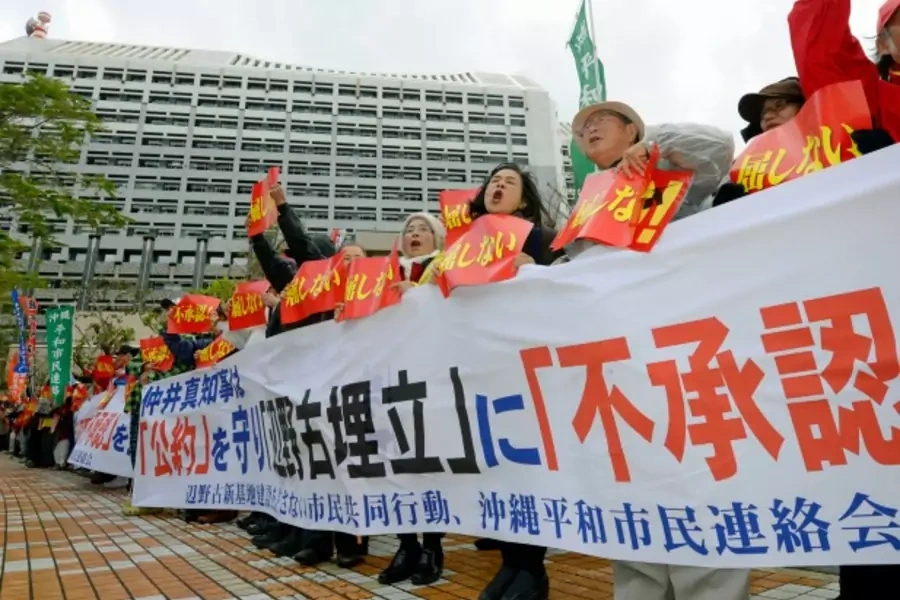Frank Mondelli: Can Recent Social Unrest Be Resolved in Okinawa’s Base Problem?

More on:
Frank Mondelli graduated from Swarthmore College in 2014 and is currently a Fulbright Fellow in Okinawa, Japan.
Seventy years into the postwar era, Okinawa is still grappling with the issues stemming from the large U.S. military presence on its soil. Recently, tensions between local citizens and U.S. and Japanese militaries over the construction of a new base have reached a critical point, resulting in an escalating series of incidents. While the U.S.-Japan alliance as a whole benefits strongly from Okinawa’s current role in their partnership, better communication needs to occur between antibase protestors and military officials if they are to peacefully and constructively navigate political and social realities.
The relocation of the Futenma base has been a contentious issue for decades. The argument for relocation, as it is advertised to the public through flyers and other forms of press, is simple: it would lessen the burden on Okinawa’s heavily populated south region. Opponents of the new base, meanwhile, criticize projected environmental damage to Okinawa’s coral reefs and native species; and since construction started in August 2014, sit-ins and other demonstrations outside the new construction zone have been increasing in frequency and intensity, often with a turn-out of several thousand citizens. Seafaring expeditions have produced evidence that the new construction has already caused serious environmental damage. In addition, many activists express their fear that Okinawa will continue to play its subservient “postwar” role for decades to come. Over the last two weeks they have held academic lectures outside the gate at night with powerpoint presentations, where some scholars have thus far discussed their theories on the connections between 9/11, terrorism, Henoko, and even the Islamic State. Many of these demonstrations are recorded live and spread through Twitter.
The increase in protests has also led to an increase in incidents between the protestors, American military police, and the Japanese Coast Guard. For example, the Japanese Coast Guard has been accused of forcibly taking protestors out several kilometers from the shore and leaving them there. Many protestors view such events not as isolated incidents but as only the latest in a long history of abuse suffered by the Okinawan people. Tactics of some protesters are equally dangerous, including firing lasers into the cockpits of approaching aircraft at night, releasing balloons intended to disrupt planes’ maneuvers, and attempting to blockade construction on sea in canoes.
A recent string of remarks by senior U.S. officials that has been viewed as insulting by local Okinawans is only further fueling anger and discontent. For example, early this year, a Marine Corps deputy public affairs officer wrote of protestors who suffered police brutality: “the attempt to appear injured is laughable when you see it in person.” Three weeks ago Major Tim Kao, a commanding officer in the Marine Corps, accused demonstrators of being paid by the Japan Communist Party. Activists have claimed that comments like these turn political free speech and protest into personal slander, and that they miss the point of the entire antibase protest.
This year, with construction of the new base underway and the seventieth anniversary of the Pacific War, the stakes are as high as ever. All sides share responsibility to work toward peaceful resolution of their disputes. To help alleviate some of the protestors’ concerns, the United States should emphasize intercultural unity and transparency. The U.S. consulate in Naha and many of the bases already host American-style events for Japanese communities. Such events should be held on a larger and more systematic basis, and would be valuable for American personnel who are unfamiliar with Japanese culture. The Japanese government should also devote more resources to promoting Okinawan culture and languages; such acknowledgement would satisfy Okinawans who believe their culture and way of speaking has been historically marginalized. Meanwhile, activists should cease methods of protest which put American personnel in danger or otherwise create unnecessary friction between the two communities. Some protestors use arguments of historical oppression to justify hate speech that discriminates against all Americans on the island. These instances do not go unnoticed among personnel and in turn have the potential to create an unsavory opinion of all Okinawans in return.
In addition to promoting intercultural interaction, all parties involved must work together to create safe and open environments for constructive discussion. Open community discussions in which locals and personnel are encouraged to verbally express their frustrations may help serve as useful and educational for both groups. In addition, the U.S. and Japanese governments should take and communicate serious steps to reduce and assess environmental impact, implement a plan for tighter oversight over the police forces, and release statements apologizing for the treatment of protestors and insensitive comments (or at least better train officials with managing their public image). In return, protestors should be receptive to these efforts, such as collaborating on the environmental assessment efforts with their own findings and research, and they should also be willing to compromise on some of their larger, more ideological goals. Activists should also ensure that their protests do not harm personnel and that they too play an active role in maintaining peaceful relations. The main objective on all sides should be to ensure that human rights, whether physical or political, are protected to the highest degree possible, while still ensuring that the U.S.-Japan alliance is maintained and strengthened.
More on:
 Online Store
Online Store